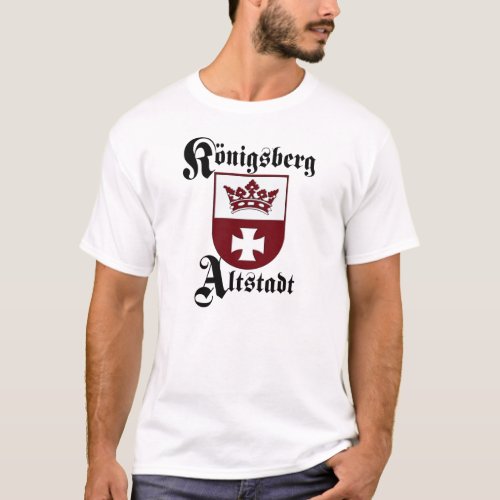Königsberg Altstadt T-Shirt



Königsberg Altstadt, the center of medieval Königsberg, came to be later bordered by Kneiphof in the south, Lomse to the southeast, Löbenicht to the east, Königsberg Castle to the north, Steindamm and Neurossgarten to the northwest, Laak to the west, and Lastadie to the southwest. Suburbs under the jurisdiction of Altstadt (Freiheiten) included Hufen, Laak, Lastadie, Lomse, Neurossgarten, and Steindamm. The Altstadt's warehouses were located in Lastadie and Lomse. Outlying villages and estates controlled by Altstadt included Kosse, Puschdorf, Stablauken, Steinbeck, Kraußen, Ottenhagen, Ratshubenhof, and Adlig Neuendorf. A wall was constructed around Altstadt from 1359-70. Because of the narrowness of the town's streets, after 1700 each newly constructed building had to be shortened by two feet to expand street width.[1] The Holzbrücke bridge, constructed by Altstadt in 1404, connected the town to Lomse. Altstadt was connected to Kneiphof by the Krämerbrücke (built 1286), the Dombrücke (built ca. 1330, destroyed 1379), and the Schmiedebrücke (built 1379). A member of the Hanseatic League by 1339, Altstadt took part in the Confederation of Cologne against King Valdemar IV of Denmark in 1367. King Frederick William I of Prussia merged Altstadt, Löbenicht, Kneiphof, and their respective suburbs into the united city of Königsberg. The Königsberg Castle and its suburbs remained separate until the Städteordnung of Stein in November 1808 during the era of Prussian reforms. Königsberg Altstadt was devastated by several attacks by the British Royal Airforce in 1944 and in also in 1945 during the Battle of Königsberg against the invading Red Army. Most of the buildings which survived World War II were subsequently demolished by the Soviet Union. Plans are in place today for the total rebuilding and full restoration of the Altstadt.


